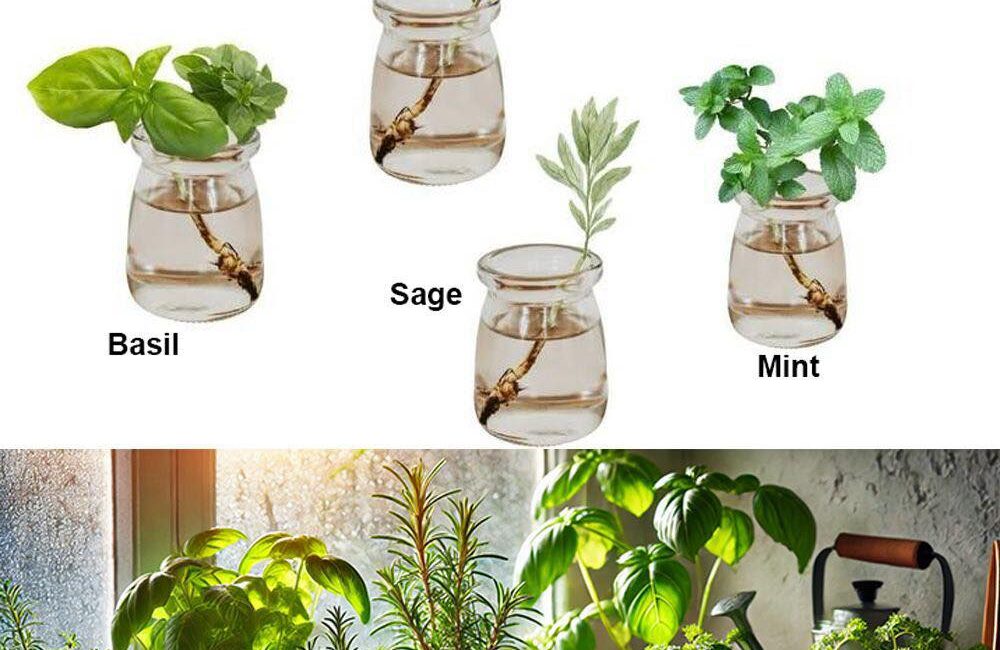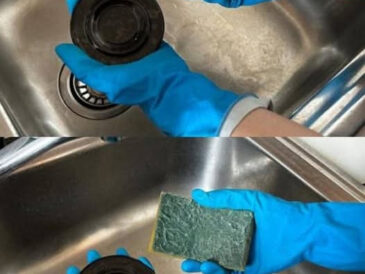Imagine a kitchen windowsill bursting with fresh, fragrant herbs, ready to elevate your culinary creations at a moment’s notice. Now, envision achieving this without the mess of soil, the hassle of repotting, or the worry of pests. This is the magic of growing herbs in water, a simple and elegant method perfect for indoor and small-space gardening.
Hydroponics is the future of sustainable indoor gardening, and growing herbs in water is one of the easiest ways to start. Hydro-herbs are not only aesthetically pleasing but also highly functional, allowing you to have fresh ingredients available all year round. This article delves into the captivating world of hydro-herbs, exploring seven aromatic wonders that thrive in water, providing detailed care instructions, and offering tips to help you cultivate your own thriving indoor herb garden.
Why Choose Hydro-Herbs? The Advantages of Growing Herbs in Water
Before we dive into the specific herbs, let’s explore why hydroponics, especially growing herbs in water, is such an attractive gardening method. Here are some key reasons:
1. Cleanliness and Convenience
Growing herbs in water means no more dealing with messy soil spills or the hassle of repotting plants as they grow. With no soil, your kitchen or garden will stay neat, and you can avoid the usual dirt accumulation that happens with traditional soil-based gardening. This clean, minimalist method is perfect for urban dwellers or those with limited space.
2. Reduced Pest and Disease Issues
Soil-borne pests and diseases are significantly less common in water-based systems, leading to healthier, more robust herbs. In soil, pests such as aphids, whiteflies, or root rot can take hold, but with water culture, you dramatically reduce these risks. This makes your indoor herb garden cleaner and easier to maintain.
3. Faster Growth and Nutrient Absorption
Herbs grown in water have direct access to nutrients dissolved in the water, which allows them to absorb them faster and more efficiently. This often results in faster growth compared to traditional soil gardening, meaning you can enjoy a steady supply of fresh herbs in no time.
4. Aesthetic Appeal
Not only are hydro-herbs functional, but they also add a visually stunning aspect to your home. The transparent containers allow you to see the plants’ roots, turning them into living works of art. Whether displayed on a kitchen windowsill or as part of your home décor, these hydroponic systems make your space feel more vibrant and alive.
5. Space Saving
If you live in a small apartment or have limited garden space, hydroponics is a game-changer. Hydroponic systems can be compact, vertical, and even mounted on walls, allowing you to make the most of every inch of space available. You can have your very own herb garden, even if you’re working with a tiny area.
6. Easy Propagation
One of the most exciting benefits of growing herbs in water is how easy it is to propagate plants. Simply cut a stem or branch from a healthy herb plant, submerge it in water, and wait for the roots to grow. This makes it incredibly easy to expand your indoor herb garden without needing to buy more plants.
The Aromatic Seven: Herbs That Thrive in Water
Now that we’ve covered the benefits of hydroponics, let’s take a closer look at seven wonderful herbs that can thrive in water. These herbs will not only enhance your meals with their aromatic qualities but also make for beautiful indoor plants.
1. Rosemary (Salvia rosmarinus)
Description: Rosemary is an evergreen herb known for its needle-like leaves and rich, piney aroma. It’s a classic herb in Mediterranean cuisine, often paired with lamb, chicken, or roasted vegetables.
Care: Rosemary enjoys bright, indirect light and well-aerated water. Change the water every week or two, ensuring that the leaves stay above the waterline to prevent rot. Rosemary is slow to root in water, so patience is key.
Tips: Use cuttings from mature, healthy rosemary plants for the best results. Rosemary thrives in cooler environments, so avoid placing it in hot spots or near heat sources.
2. Oregano (Origanum vulgare)
Description: Oregano is a robust herb with a warm, earthy, and slightly bitter flavor, widely used in Italian and Mediterranean cooking. Its fragrant leaves make it a favorite for pizza, pasta, and marinades.
Care: Oregano prefers bright, indirect light. It’s important to change the water regularly and pinch off the top growth to encourage a bushier plant. This herb is especially easy to propagate and can root quickly in water.
Tips: Oregano is one of the most forgiving herbs to grow in water, making it ideal for beginner gardeners. Be sure to cut healthy stems and remove any lower leaves before submerging them.
3. Thyme (Thymus vulgaris)
Description: Thyme is a low-growing herb with tiny, aromatic leaves. It has a delicate, earthy flavor and is a staple in French cuisine. Thyme pairs wonderfully with roasted meats, soups, and sauces.
Care: Thyme needs bright, indirect light and prefers well-aerated water. Change the water every week or two, and ensure the leaves do not touch the water to avoid rot. Like rosemary, thyme can be slow to root, so be patient.
Tips: Thyme benefits from occasional pruning to encourage new growth. Be sure to use cuttings from mature plants for best results.
4. Sage (Salvia officinalis)
Description: Sage is a woody herb with soft, silvery leaves and a strong, earthy flavor. It’s often used in savory dishes and pairs excellently with poultry, pork, and stuffing.
Care: Sage prefers bright, indirect light and well-aerated water. Change the water every week or two and keep the leaves above the water to prevent rotting. Sage roots slowly, so patience is essential.
Tips: Use cuttings from healthy, mature sage plants and avoid placing the herb in overly moist conditions, as sage can be sensitive to excessive humidity.
5. Basil (Ocimum basilicum)
Description: Basil is one of the most popular herbs worldwide, known for its bright, peppery, and slightly sweet flavor. It’s a cornerstone in Italian cuisine and perfect for fresh dishes like pesto and caprese salad.
Care: Basil thrives in bright, indirect light and requires regular water changes to keep it healthy. Pinch off the top growth to promote a bushier plant. Basil roots easily in water, making it ideal for hydroponic gardening.
Tips: Basil is very sensitive to temperature changes, so keep it in a warm, stable environment. It also prefers a light mist of water on its leaves to mimic its natural humid habitat.
6. Mint (Mentha spp.)
Description: Mint is a refreshing herb with fragrant leaves that come in a variety of types, such as peppermint, spearmint, and chocolate mint. It’s perfect for tea, cocktails, and even savory dishes.
Care: Mint thrives in bright, indirect light and needs regular water changes to keep the roots healthy. Mint can grow quite quickly in water, so be prepared to harvest frequently to prevent it from becoming too invasive.
Tips: Mint is very prolific and can quickly take over its container, so regular pruning is key. Use cuttings from healthy plants and keep an eye on the root system to ensure it stays manageable.
Setting Up Your Hydro-Herb Garden: A Step-by-Step Guide
Now that you’ve chosen your herbs, let’s discuss how to set up your hydroponic herb garden in a few simple steps:
- Choose Your Herbs: Select herbs that grow well in water, such as those mentioned above. Ensure that the plants are healthy and mature to begin with.
- Select Containers: Use clear containers, such as glass jars, vases, or plastic bottles. Transparent containers not only showcase the roots, but they also allow you to monitor the water level and health of the plant more easily.
- Prepare the Water: Use tap water that has been left to sit for 24 hours to allow chlorine to evaporate. Alternatively, distilled or filtered water is a great option to keep your herbs healthy.
- Prepare Cuttings: Cut a healthy stem from a mature herb plant. The stem should have several nodes (leaf junctions). Trim away any lower leaves that will be submerged in water.
- Place Cuttings in Containers: Place the cut end of the herb stem into the container, ensuring the cut end is submerged in water while the leaves remain above the waterline.
- Provide Light: Place your containers in a location with bright, indirect light. Avoid direct sunlight, which can scorch the delicate leaves.
- Change Water Regularly: Change the water every week or two to prevent stagnation. Regular water changes will also help replenish nutrients.
- Add Nutrients (Optional): For herbs that require more nutrients, consider adding a diluted hydroponic nutrient solution to the water.
Tips for Success:
- Monitor Water Levels: Regularly check the water levels and add more as needed to keep the roots submerged.
- Clean Containers: Clean your containers every few weeks to prevent algae growth or the buildup of organic matter.
- Prune Roots: Trim any decaying or excessively long roots to encourage healthy new growth.
- Pinch Off Top Growth: Pinch off the top growth to help the plants become bushier and more productive.
- Harvest Regularly: Harvest your herbs regularly to encourage new growth and maintain a fresh supply of aromatic leaves.
Conclusion:
Growing herbs in water offers a unique and rewarding experience
, combining the beauty of nature with the simplicity of hydroponics. With the right selection of herbs and proper care, you can create a thriving indoor herb garden that adds a touch of freshness and flavor to your culinary creations. So, dive into the world of hydro-herbs and discover the joy of cultivating your own aromatic wonders without the fuss of soil!




